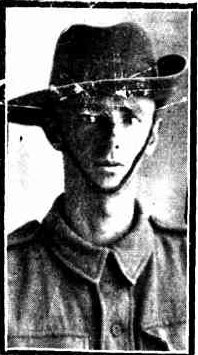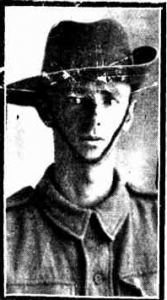When he enlisted in July 1915 Walter William Erickson was employed as the Junior Master at Wolaroi Grammar School in Orange. Walter had attempted to enlist on two previous occasions, but was unsuccessful. He travelled to Brisbane to enlist, and was accepted on his third attempt.
Walter was born in Cowra in 1892, the son of Swedish immigrant and carpenter Emil ‘Edward William’ Erickson and his wife Clara Louisa. The family moved to Queensland following Walter’s birth. Walter attended Monkland State School in Gympie, where he was awarded the Smyth medal, and in 1906, a State scholarship. In 1906 he also sat the annual Scripture examinations in connection with the Queensland Sunday School Union, and was awarded 16th prize in the Lower Intermediate Division.
Walter’s senior education was at Maryborough Grammar School, where he served for two years in the Senior Cadets.
In 1908 Walter successfully completed the Sydney University Junior Examinations, and in January 1909 returned to Monkland State School as a pupil teacher on probation. He completed his teaching apprenticeship in 1911. During this time he was a member of the Ancient Order of Foresters, and was Secretary of the Gympie branch for two and a half years.
By November 1914 Walter had moved to Orange and was a popular master at Wolaroi Grammar School. Walter’s dedication to his charges and his enthusiasm on the sporting field endeared him to fellow teachers and students alike. According to Wolaroi headmaster, Mr CR Campbell, “As soon as war was declared, [Walter] became restless in his desire to serve his country, and, at last, unable to remain longer deaf to duty’s call, he offered his services”.
According to his enlistment papers of July 1915 Walter was 1.7 metres tall, with grey eyes, and light brown hair. He was described as having a fresh complexion and clear skin. He proceeded to Enoggera training camp in Brisbane, a Private in the 31st Battalion, A Company. In August Walter was promoted to Sergeant, and on 9 November 1915 embarked from Melbourne for overseas service.
Sergeant Erickson served in Egypt for six months then, in June 1916, joined the British Expeditionary Force in France. On 12 October 1916 the 31st Battalion was engaged in a raid on the “Chicken Run” in the Houplines sector near Armentieres. The commanding officer described the raid as “very successful”: three prisoners and one machine gun were captured, as well as other equipment. Unfortunately though, Walter was mortally wounded during the attack. He was aged 24 years and three months. According to Lieutenant Brodie of the 31st Battalion Walter was engaged in this “brilliant raid, the success of which depended a great deal on the example set by the deceased”. Walter was buried in the Cite Bonjean Military Cemetery at Armentieres.
Water William Erickson is commemorated on the following honour rolls: St John’s Presbyterian Church Orange, Monkland State School, Maryborough Grammar School, and on panel number 118 on the Roll of Honour at the Australian War Memorial in Canberra. He is also commemorated on the World War I Roll of Honour on the southern face of the Orange Cenotaph. On 6 February 1917 the Reverend JC McDonald unveiled a photograph of Walter at Wolaroi Grammar School.
Every year Walter’s family inserted a memorial notice in the newspaper to commemorate the anniversary of his death. This tradition continued until 1938.
His King and country called him,
The call was not in vain;
For on our roll of honour
You will find our hero’s name.
He sleeps not in his native land,
But under foreign skies,
Far from those who loved him,
But in a hero’s grave he lies.
He died as he lived, for others.
Leader, 9 February 1917, p. 5.
In Memory Of A Wolaroi Master


